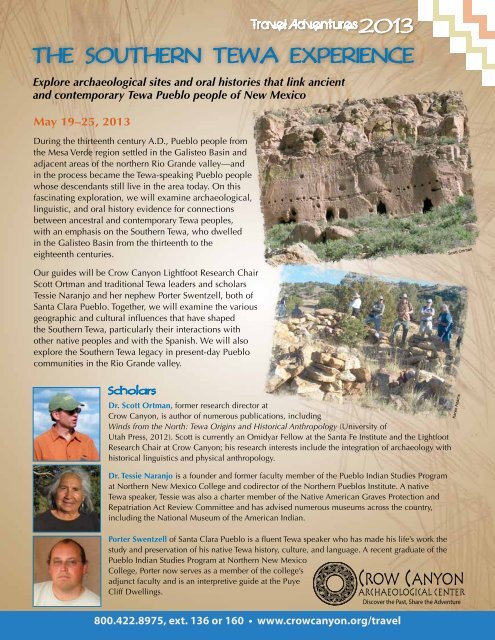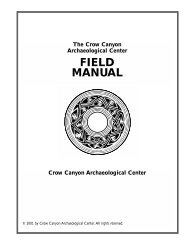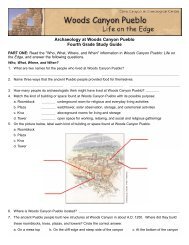THE SOUTHERN TEWA EXPERIENCE - Crow Canyon ...
THE SOUTHERN TEWA EXPERIENCE - Crow Canyon ...
THE SOUTHERN TEWA EXPERIENCE - Crow Canyon ...
Create successful ePaper yourself
Turn your PDF publications into a flip-book with our unique Google optimized e-Paper software.
Travel Adventures 2013<br />
<strong>THE</strong> SOU<strong>THE</strong>RN <strong>TEWA</strong> <strong>EXPERIENCE</strong><br />
Explore archaeological sites and oral histories that link ancient<br />
and contemporary Tewa Pueblo people of New Mexico<br />
May 19–25, 2013<br />
During the thirteenth century A.D., Pueblo people from<br />
the Mesa Verde region settled in the Galisteo Basin and<br />
adjacent areas of the northern Rio Grande valley—and<br />
in the process became the Tewa-speaking Pueblo people<br />
whose descendants still live in the area today. On this<br />
fascinating exploration, we will examine archaeological,<br />
linguistic, and oral history evidence for connections<br />
between ancestral and contemporary Tewa peoples,<br />
with an emphasis on the Southern Tewa, who dwelled<br />
in the Galisteo Basin from the thirteenth to the<br />
eighteenth centuries.<br />
Our guides will be <strong>Crow</strong> <strong>Canyon</strong> Lightfoot Research Chair<br />
Scott Ortman and traditional Tewa leaders and scholars<br />
Tessie Naranjo and her nephew Porter Swentzell, both of<br />
Santa Clara Pueblo. Together, we will examine the various<br />
geographic and cultural influences that have shaped<br />
the Southern Tewa, particularly their interactions with<br />
other native peoples and with the Spanish. We will also<br />
explore the Southern Tewa legacy in present-day Pueblo<br />
communities in the Rio Grande valley.<br />
Scholars<br />
Dr. Scott Ortman, former research director at<br />
<strong>Crow</strong> <strong>Canyon</strong>, is author of numerous publications, including<br />
Winds from the North: Tewa Origins and Historical Anthropology (University of<br />
Utah Press, 2012). Scott is currently an Omidyar Fellow at the Santa Fe Institute and the Lightfoot<br />
Research Chair at <strong>Crow</strong> <strong>Canyon</strong>; his research interests include the integration of archaeology with<br />
historical linguistics and physical anthropology.<br />
Dr. Tessie Naranjo is a founder and former faculty member of the Pueblo Indian Studies Program<br />
at Northern New Mexico College and codirector of the Northern Pueblos Institute. A native<br />
Tewa speaker, Tessie was also a charter member of the Native American Graves Protection and<br />
Repatriation Act Review Committee and has advised numerous museums across the country,<br />
including the National Museum of the American Indian.<br />
Porter Swentzell of Santa Clara Pueblo is a fluent Tewa speaker who has made his life’s work the<br />
study and preservation of his native Tewa history, culture, and language. A recent graduate of the<br />
Pueblo Indian Studies Program at Northern New Mexico<br />
College, Porter now serves as a member of the college’s<br />
adjunct faculty and is an interpretive guide at the Puye<br />
Cliff Dwellings.<br />
800.422.8975, ext. 136 or 160 • www.crowcanyon.org/travel<br />
Scott Ortman<br />
Karen Adams<br />
CROW CANYON<br />
ARCHAEOLOGICAL CENTER<br />
Discover the Past, Share the Adventure
All photos by Karen Adams<br />
Dates: Sunday, May 19–Saturday, May 25, 2013<br />
Tuition: Member* $2,795 • Nonmember $2,920<br />
Deposit: $400 • Balance due: March 20, 2013<br />
*Minimum $100 membership required. For information on<br />
membership, visit www.crowcanyon.org/membership.<br />
Educational Focus<br />
• How differences in geography, landscape, and<br />
cultural contacts shape the histories of specific<br />
communities within an archaeological area<br />
• How oral traditions, traditional knowledge,<br />
and archaeology interact to create a richer<br />
understanding of human history<br />
• How ancestral Pueblo people created a rich and<br />
vibrant society without social stratification<br />
• What the Southern Tewa experience can teach<br />
us about contemporary society<br />
Tour Details<br />
Tuition: Tuition is per person and based on shared<br />
accommodations. Tuition includes accommodations, meals<br />
listed, entry fees and permits, most gratuities, and transportation<br />
from arrival in Albuquerque, New Mexico, on Sunday,<br />
May 19, 2013, until departure from Albuquerque on Saturday,<br />
May 25, 2013. Transportation to and from Albuquerque<br />
is your responsibility.<br />
Accommodations: Four nights are spent in excellent<br />
hotels. Two nights are spent at a resort spa with first-class<br />
accommodations, lovely landscaped grounds, and excellent<br />
spa services. Accommodations are double-occupancy; single<br />
accommodations are available for an additional fee of $495.<br />
What to Expect: All travel is by <strong>Crow</strong> <strong>Canyon</strong> vehicle. We will<br />
explore archaeological sites located at elevations between 5000<br />
and 9000 feet. You must be able to walk and stand for up to one<br />
hour during on-site discussions. Access to most sites requires<br />
moderate hikes of no more than 2 miles round-trip; some hikes<br />
are over uneven terrain. Tuesday’s hike in the Comanche Gap<br />
area is more challenging and demands some climbing and<br />
scrambling. An alternative activity will be provided.<br />
Detailed Itinerary<br />
B: Breakfast<br />
L: Lunch<br />
D: Dinner<br />
Most of the sites we visit on this<br />
tour are not readily accessible<br />
to the general public. We have<br />
received special permission to visit sites<br />
on private land belonging to the Singleton<br />
family, the Sandoval family, and the Archaeological<br />
Conservancy, and we have secured permits from the<br />
state of New Mexico, Bureau of Land Management,<br />
and National Park Service to visit sites and curation<br />
facilities on state and federal lands.<br />
Sunday, May 19: Arrival in Albuquerque •<br />
Introduction<br />
Arrive in Albuquerque, New Mexico, by<br />
4:30 p.m. for reception and dinner. Overnight,<br />
Albuquerque. (D)<br />
Monday, May 20: Petroglyph Hill • Lamy<br />
Junction • Las Madres • Pueblo Galisteo<br />
Today we get an overview of the Southern Tewa<br />
experience by visiting a number of seldomvisited<br />
sites in the Galisteo Basin. Our first stop<br />
is Petroglyph Hill, a prominent landform littered<br />
with dark, volcanic rock on which hundreds<br />
of images have been pecked. There we enjoy<br />
a panoramic view of the Galisteo Basin while<br />
examining early petroglyphs and considering<br />
their relationship to rock art of the Mesa Verde<br />
region. Then it’s on to the Lamy Junction and<br />
Las Madres sites, two villages constructed by<br />
the first Tewa people to arrive in the area in<br />
the late thirteenth century. Finally, we visit<br />
Pueblo Galisteo, a Southern Tewa village that<br />
was established in the fourteenth century and<br />
inhabited into the eighteenth century, when<br />
the last Southern Tewa people left the basin<br />
and moved to Santo Domingo (Kewa) Pueblo.<br />
Overnight, spa outside Santa Fe. (B, L, D)
Tuesday, May 21: Comanche Gap • Creston Dike<br />
Petroglyphs • San Cristóbal<br />
Joined by renowned rock art researcher and author Polly<br />
Schaasfma, we explore the spectacular Rio Grande–style<br />
petroglyphs on Creston Dike, an igneous formation in the<br />
Comanche Gap area. The dike and other rock outcrops in<br />
this area literally bristle with elaborate imagery, ranging<br />
from spirit beings and celestial objects to depictions of<br />
warfare, such as shields and warriors. As we view the rock<br />
art, we discuss the interaction between Pueblo and Plains<br />
peoples in the Galisteo Basin and examine how that<br />
interaction helped shape the Southern Tewa experience.<br />
In the afternoon, we visit the archaeological site of San<br />
Cristóbal, one of the largest Southern Tewa villages at<br />
which evidence of biological continuity with Mesa Verde<br />
people has been discovered. Overnight, spa outside<br />
Santa Fe. (B, L, D)<br />
Wednesday, May 22: La Cieneguilla •<br />
San Marcos Pueblo<br />
This morning we visit the site of La Cieneguilla, a village<br />
inhabited by Tewa and Keres people from the fourteenth<br />
through eighteenth centuries and located near some of<br />
the best farmland in the northern Rio Grande valley. The<br />
remarkable diversity of pottery on the surface is evidence<br />
of the rich interactions between Southern Tewas and other<br />
Pueblo peoples and serves as a backdrop for a discussion<br />
of traditional Pueblo economic systems.<br />
In the afternoon, we visit San Marcos Pueblo, a very large<br />
village inhabited from the fourteenth through seventeenth<br />
centuries. There we explore interactions between<br />
Southern Tewa and Keres peoples, examine evidence of<br />
turquoise mining and glaze-painted pottery production,<br />
and consider the impacts of Spanish colonialism on the<br />
Pueblo people of the Rio Grande valley. Overnight,<br />
Santa Fe. (B, L)<br />
Karen Adams<br />
Thursday, May 23: Arroyo Hondo Pueblo • Rowe<br />
Pueblo • Pecos National Historical Park<br />
Guest scholar Dr. Linda Cordell (senior scholar at<br />
the School for Advanced Research and a member<br />
of the external faculty of the Santa Fe Institute)<br />
guides us through the pueblo of Arroyo Hondo, an<br />
intensively excavated fourteenth-century Southern<br />
Tewa village on the outskirts of Santa Fe. We then<br />
travel to Rowe Pueblo, a site in the Pecos valley<br />
investigated by Linda in the 1980s that appears to<br />
have been established by immigrants from the Mesa<br />
Verde region. We end the day with a visit to Pecos<br />
National Historical Park to consider the Southern<br />
Tewa contribution to this important Pueblo and Plains<br />
Indian trading center. Overnight, Santa Fe. (B, L)<br />
Friday, May 24: Puye Cliff Dwellings • Chimayo •<br />
Santa Clara Pueblo<br />
This morning Porter guides us on a special tour<br />
of Puye Cliff Dwellings, focusing on rock art and<br />
evidence of a Southern Tewa presence at this major<br />
ancestral Santa Clara Pueblo site. We also visit the<br />
historic Hispanic church (“el Santuario”) at nearby<br />
Chimayo to discuss Tewa influences on Hispanic New<br />
Mexican culture. Then, in a fitting conclusion to our<br />
week, we visit Santa Clara Pueblo for a traditional<br />
Pueblo dinner and closing program. This evening we<br />
drive to Albuquerque. Overnight, Albuquerque.<br />
(B, L, D)<br />
Saturday, May 25: Departures from Albuquerque<br />
Departures may be scheduled for any time after<br />
breakfast. (B)<br />
Itinerary subject to change.<br />
Karen Adams
Tour Reservations<br />
Phone: Call 800.422.8975, ext. 136 or 160, Mon–Fri,<br />
8 a.m. to 5 p.m. (Mountain Time).<br />
Online: Use the secure reservation form at<br />
www.crowcanyon.org/travel.<br />
Please Note: Online requests are subject to availability. Your credit<br />
card will not be charged until your registration is fully processed and<br />
confirmed by <strong>Crow</strong> <strong>Canyon</strong>.<br />
Late Reservations: To secure reservations on a trip for which the final<br />
payment deadline has passed, full payment by credit card is required<br />
at the time of your reservation. Last-minute reservations are subject<br />
to space availability and may require the payment of late fees.<br />
Cancellation: All cancellation requests must be made in writing to<br />
<strong>Crow</strong> <strong>Canyon</strong> Registrar, 23390 Road K, Cortez, CO 81321-9408, or<br />
e-mailed to travel@crowcanyon.org. Cancellations become effective<br />
on the date received. The following penalty schedule applies: On or<br />
before March 20, 2013: $200 handling fee; after March 20, 2013:<br />
forfeiture of all payments.<br />
Group Size: Our programs are designed for small groups. A minimum<br />
number of participants is required for each trip. If this minimum is<br />
not reached by the final payment date, you may be offered several<br />
options: pay a slightly higher program price, select another program,<br />
or receive a full refund. Please contact us to check program status<br />
before making your travel arrangements.<br />
<strong>Crow</strong> <strong>Canyon</strong> is a 501(c)(3) not-for-profit organization whose mission is to advance knowledge of the human experience through archaeological research, education programs, and<br />
collaboration with American Indians.<br />
The <strong>Crow</strong> <strong>Canyon</strong> Archaeological Center’s programs and admission practices are open to applicants of any race, color, nationality, ethnic origin, gender, or sexual orientation.<br />
<strong>Crow</strong> <strong>Canyon</strong> reserves the right to withdraw, without penalty, any announced program (in which case, a full refund of the purchase price will be made) or to make necessary changes<br />
to a program or program schedule. <strong>Crow</strong> <strong>Canyon</strong> is not responsible, in the event of cancellation or alteration of a program, for any airline or other commercial transportation<br />
cancellation penalty incurred by purchasing a nonrefundable or restricted ticket. Please contact us about program status before making your travel arrangements. We strongly<br />
recommend that you purchase travel insurance; information about travel insurance will be sent to you as a service. Terms and conditions will be sent as part of your registration<br />
package; this information is also available online at www.crowcanyon.org/travel.<br />
Registration as a seller of travel does not constitute approval by the State of California – CST 2059347-50. © 2012 by <strong>Crow</strong> <strong>Canyon</strong> Archaeological Center. All rights reserved.<br />
800.422.8975, ext. 136 or 160 • www.crowcanyon.org/travel<br />
All photos by Karen Adams






